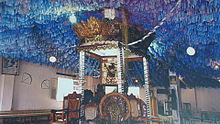Ilê Axé Iyá Nassô Oká
| Ilê Axé Iyá Nassô Oká | |
|---|---|

Interior of Casa Branca of Ilé Axé Iya Nassô Oká
|
|
| Basic information | |
| Geographic coordinates | 12°59′49″S 38°29′42″W / 12.997081°S 38.494881°W |
| Affiliation | Candomblé |
| Deity | Oxossi, Xango |
| Sect | Ketu |
| Municipality | Salvador |
| State | Bahia |
| Country | Brazil |
| Designated | 1986 |
| Reference no. | 1067 |
Ilê Axé Iyá Nassô Oká is a Candomblé terreiro in Salvador, Bahia, Brazil. It is also known as the Casa Branca do Engenho Velho, Terreiro Casa Branca, or simply the Casa Branca. It is located on Vasco da Gama Avenue in the Engenho Velho neighborhood of Salvador. The terreiro is associated with the Ketu branch of the religion and is publicly represented by the Sociedade São Jorge do Engenho Velho. Ilê Axé Iyá Nassô Oká was incorporated by the mid-19th century but traces its lineage an earlier period. Ilê Axé Iyá Nassô Oká is considered to be the oldest Candomblé terreiro in Brazil, and was the first non-Roman Catholic and first Afro-Brazilian religious place of worship to receive heritage status from the National Institute of Historic and Artistic Heritage (IPHAN). The terreiro covers 6,800 square metres (73,000 sq ft) and includes religious structures, sacred objects, trees associated with Candomblé rituals, and open space.
Ilê Axé Iyá Nassô Oká traces its origins to Terreiro de la Barroquinha, which was founded in the 19th century by three freed slaves of African birth: Iyá Nassô, Iyá Kalá and Iyá Detá. Iyá Nassô rented land at the abandoned Velho do Rio Vermelho de Baixo sugar mill, on what is now Vasco da Gama Avenue, and created a new terreiro at the location. Members of the group traveled to Africa in the early 19th century to "study and assure the authenticity of the ritual and doctrine" of their faith. The terreiro was formally founded in the 1830s; the Jornal da Bahia of May 3, 1855 contains the earliest published reference to the terreiro Engenho Velho. Succession disputes at the terreiro led to the establishment of two new terriros: Ilê Iyá Omi Axé Iamassé in the Gantois neighborhood, and Ilê Axé Opô Afonjá in the São Gonçalo neighborhood. Both remain active and are also central centers of Candomblé in Brazil. The terreiro was registered as a public entity under the name Sociedade Beneficente e Recreativa São Jorge do Engenho Velho in on July 25, 1943.
The existence of the Ilê Axé Iyá Nassô Oká was threatened in the early 1980s due to real estate speculation. The terreiro did not own the land on which it sat and the land owner put the property up for sale; the terreiro was threatened with expulsion from the area. A social movement to preserve the terreiro began in this period with the support of the Afro-Brazilian political groups, local politicians, and population of Salvador. Public personalities such as Mãe Menininha do Gantois, Jorge Amado, the artist Carybé, Dorival Caymmi, and Oscar Niemeyer advocated for preservation of the terriro. The city of Salvador gave historic preservation status to the terreiro in 1982, studies by the federal government followed in 1983 and federal landmark status in 1985.
...
Wikipedia
